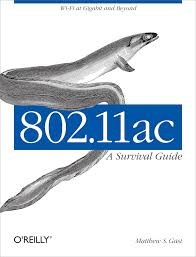Book Review: 802.11ac - A Survival Guide
By CWNP On 01/29/2014 - 33 Comments
A review by Tom Carpenter, CTO of CWNP, of 802.11ac - A Survival Guide written by Matthew Gast, and key takeaways garnered.
First, let me say that I love the "Survival Guide" concept employed in the 802.11ac book by Matthew Gast and the 802.11n book before it. The concept of building on to the 802.11 Wireless Networks – The Definitive Guide with these books is brilliant and makes for simpler reading for those who have been in the industry for some time.
Like the 802.11n – A Survival Guide (2012) before it, 802.11ac – A Survival Guide (hereafter known as 802.11ac-ASG) presents the new capabilities of a physical layer (with some Data Link layer additions/modifications) addition to the standard rather than injecting the new information into an update to the complete book (802.11 Wireless Networks - The Definitive Guide). If you are completely new to the wireless industry or just starting to truly learn how 802.11 networks work, you really should read The Definitive Guide first; however, if you are a CWNA or above, you are well prepared to read and understand 802.11ac-ASG.
The book is divided into five chapters, making it easy to quickly locate the knowledge you seek. The first chapter provides a high-level overview of 802.11ac with a bit of history and then the new features provided. Then chapter two introduces the new physical layer (PHY), which is called Very High Throughput (VHT) in the standard. Chapter three covers the MAC (a Data Link sublayer) changes. Chapter 4 helps you to wrap your mind around one of the hot topics in 802.11ac: beamforming. Finally, chapter 5 provides an overview of the 802.11ac planning process.
With that overview complete, let me share a few sections of the book that I feel were most valuable.
First, the overview of 256-QAM, in Gast's trademark ability to simplify the complex, grants the reader an understanding of this modulation that is more than sufficient for anyone doing the work of a network administrator or engineer. Remember, only the chipset makers and low-level programmers need to master the very fine details of modulation methods. We, as administrators and engineers, must know enough about them to plan for their availability and functionality when required. For example, we need to understand enough about 256-QAM to implement 802.11 in areas that require this highest level of throughput (more accurately data rate) provided so that users can indeed connect in those areas at those throughput levels. Matthew helps you to understand that the error vector plays a big role in the ability of the receiver to receive and process a signal at this high data rate.
The second area I found to provide an exceptional summary was the section (on page 47) titled Basic Channel Access Rules. Here, clarity is delivered in the area of channel access and it provides this clarity in simple terms, which is most important as you initially learn these concepts. The end understanding is that CCA must be performed across primary and secondary channels for proper transmission of data.
The third area of great benefit is an entire chapter. Chapter 4, Beamforming in 802.11ac, is a must read for any serious student of wireless networking. Here, you will learn all you need to know to understand beamforming and ensure that you are selecting the appropriate equipment to make it available in your environment as the various vendors provide this feature. As the chapter reminds us, "because 802.11ac beamforming is based on explicit channel measurements, both the transmitter and the receiver must support it." Stated differently, your wireless client must support is as well as the AP. This kind of good, to-the-point, information permeates this chapter.
Of course, the final chapter on planning for 802.11ac is a valuable section as well. Understanding the equipment that is available today as opposed to what should be available in late 2014 or early 2015, may indeed impact your decision for migration. You may choose to wait until wave 2 so that you are upgrading to all the key features of 802.11ac instead of just some of them. Of course, we will not have 8x8:8 in the next year or two, but we should at least see MU-MIMO.
In the end, Matthew Gast's book, 802.11ac-ASG is a must read for wireless network administrators and engineers. If you are a CWNA or even hold our professional level certifications, this book will be of great benefit in your continuous learning process.
Blog Disclaimer: The opinions expressed within these blog posts are solely the author’s and do not reflect the opinions and beliefs of the Certitrek, CWNP or its affiliates.





0 Responses to Book Review: 802.11ac - A Survival Guide
Subscribe by EmailThere are no comments yet.
<< prev - comments page 1 of 1 - next >>
Leave a Reply
Please login or sign-up to add your comment.